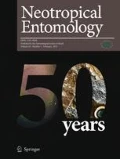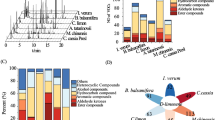Abstract
Nasutitermes corniger (Motschulsky, 1855) (Termitidae: Nasutitermitinae) is an important pest in urban environments and bioinsecticides can be an alternative to its control. Here, we determined the toxicity and repellence of the essential oil (EO) prepared from stems of Aristolochia trilobata L. (Aristolochiaceae) and its major constituents on N. corniger. We also investigated behavioral changes of individuals exposed to limonene. The lethal dose required to kill 50% of N. corniger population (LD50) of EO of A. trilobata was 2.44 μg mg−1. Limonene was the most toxic compound to N. corniger followed by linalool (LD50 = 1.02 and 1.29 μg mg−1, respectively). In addition, all treatments presented median lethal time (LT50) less than 11 h. A. trilobata EO and its constituents showed irritability activity, but only limonene repelled soldiers more than workers. The negative behaviors of N. corniger groups were higher in individuals treated with limonene. A. trilobata EO and its constituents, especially the limonene, are promising for the control of N. corniger due the high toxicity, repellence, and possible disturbance in the colonies.



Similar content being viewed by others
References
Abbott WS (1925) A method of computing the effectiveness of an insecticide. J Econ Entomol 18:265–267
Almeida CS, Cristaldo PFC, Florencio DF, Cruz NG, Santos AA, Oliveira AP, Santana AA, Ribeiro EJM, Lima APS, Bacci L, Araújo APA (2016) Combined foraging strategies and soldier behavior in Nasutitermes aff. coxipoensis (Blattodea: Termitoidea: Termitidae). Behav Process 126:76–81
Bacci L, Lima JKA, Araújo APA, Blank AF, Silva IMA, Santos AA, Santos ACC, Alves PB, Picanço MC (2015) Toxicity, behavior impairment, and repellence of essential oils from pepper-rosmarin and patchouli to termites. Entomol Exp Appl 156:66–76
Boulogne I, Constantino R, Amusant N, Falkowski M, Rodrigues AMS, Houël E (2016) Ecology of termites from the genus Nasutitermes (Termitidae: Nasutitermitinae) and potential for science-based development of sustainable pest management programs. J Pest Sci 2004:1–19
Bustamante N, Martius C (1998) Nutritional preferences of wood-feeding termites inhabiting floodplain forests of the Amazon river, Brazil. Acta Amaz 28:391–307
Constantino R (2002a) The pest termites of South America: taxonomy, distribution and status. J Appl Entomol 126:355–365
Constantino R (2002b) An illustrated key to neotropical termite genera (Insecta: Isoptera) based primarily on soldiers. Zootaxa 40:1–40
Duetz WA, Bouwmeester H, Beilen JB, Witholt B (2003) Biotransformation of limonene by bacteria, fungi, yeasts, and plants. Appl Microbiol Biotechnol 61:269–277
Eisner T, Kriston I, Aneshansley DJ (1976) Defensive behavior of a termite (Nasutitermes exitiosus). Behav Ecol Sociobiol 1:83–125
Enan E (2001) Insecticidal activity of essential oils: octopaminergic sites of action. Comp Biochem Physiol C 130:325–337
Enan E (2005) Molecular response of Drosophila melanogaster tyramine receptor cascade to plant essential oils. Insect Biochem Mol Biol 35:309–321
Evans TA, Iqbal N (2015) Termite (order Blattodea, infraorder Isoptera) baiting 20 years after commercial release. Pest Manag Sci 71:897–906
Gazal V, Bailez O, Viana-Bailez AM, Aguiar-Menezes EL, Menezes EB (2012) Decayed wood affecting the attraction of the pest arboretum termite Nasutitermes corniger (Isoptera: Termitidae) to resource foods. Sociobiology 59:287–296
Gush TJ, Bentley BL, Prestwich GD, Thorne BL (1985) Chemical variation in defensive secretions of four species of Nasutitermes. Biochem Syst Ecol 13:329–336. https://doi.org/10.1016/0305-1978(85)90044-4
Haddi K, Oliveira EE, Faroni LRA, Guedes DC, Miranda NN (2015) Sublethal exposure to clove and cinnamon essential oils induces hormetic-like responses and disturbs behavioral and respiratory responses in Sitophilus zeamais (Coleoptera: Curculionidae). J Econ Entomol 108:2815–2822
Lima JKA, Albuquerque ELD, Santos ACC, Oliveira AP, Araújo APA, Blank AF, Arrigoni-Blank MF, Alves PB, Santos DA, Bacci L (2013) Biotoxicity of some plant essential oils against the termite Nasutitermes corniger (Isoptera: Termitidae). Ind Crop Prod 47:246–251
McPartland T (2004) Ant spray containing d-limonene and methods of making and 348 using the same. 1–4
Mello AP, Costa BG, Santos AC, Silva AMB, Bezerra-Gusmão MA (2014) Termites in historical buildings and residences in the semiarid region of Brazil. Sociobiology 61:318–323
Mello AP, Azevedo RN, Barbosa-Silva AM, Bezerra-Gusmão MA (2016) Chemical composition and variability of the defensive secretion in Nasutitermes corniger (Motschulsky, 1885) in urban area in the Brazilian semiarid region. Entomotropica 31:82–90
Oliveira BM, Melo CR, Alves PB, Santos AA, Santos AC, Santana AD, Araújo APA, Nascimento PE, Blank AF, Bacci L (2017) Essential oil of Aristolochia trilobata: synthesis, routes of exposure, acute toxicity, binary mixtures and behavioral effects on leaf-cutting ants. Molecules 22:335
Park TJ, Seo HK, Kang BJ, Kim KT (2001) Noncompetitive inhibition by camphor of nicotinic acetylcholine receptors. Biochem Pharmacol 61:787–793
Perry NB, Anderson RE, Brennan NJ, Douglas MH, Heaney AJ, McGimpsey JA, Smallfield BM (1999) Essential oils from dalmatian sage (Salvia officinalis L.): variations among individuals, plant parts, seasons, and sites. J Agric Food Chem 47:2048–2054
Regnault-Roger C, Vincent C, Arnason JT (2012) Essential oils in insect control: low-risk products in a high-stakes world. Annu Rev Entomol 57:405–424
SAEG (2007) Sistema para análises estatísticas, versão 9.1. Fundação Arthur Bernardes - UFV, Viçosa
Santos DDA, Alves PB, Costa EV, Franco CRP, Nepel A, Barison A (2014) Volatile constituents of Aristolochia trilobata L. (Aristolochiaceae): A rich source of sulcatyl acetate. Quim. Nova 37:977–981.
Santos CP, de Oliveira TC, Pinto JAO, Fontes SS, Cruz EMO, Arrigoni-Blank MF, Andrade TM, Matos IL (2015) Chemical diversity and influence of plant age on the essential oil from Lippia sidoides Cham. germplasm. Ind Crop Prod 76:416–421
SAS Institute (2008) SAS/STAT 9.2 User’s Guide
Scheffrahn RH, Hochmair HH, Kern WH, Warner J, Krecek J, Maharajh B, Cabrera BJ, Hickman RB (2014) Targeted elimination of the exotic termite, Nasutitermes corniger (Isoptera: Termitidae: Nasutitermitinae), from infested tracts in southeastern Florida. Int J Pest Manage 60:9–21
Tak J-H, Jovel E, Isman MB (2015) Contact, fumigant, and cytotoxic activities of thyme and lemongrass essential oils against larvae and an ovarian cell line of the cabbage looper, Trichoplusia ni (Lepidoptera:Noctuidae). Pest Manag Sci 89:183–193
Thorne BL (1984) Polygyny in the neotropical termite Nasutitermes corniger: life history consequences of queen mutualism. Behav Ecol Sociobiol 14:117–136
Tong F, Coats JR (2012) Quantitative structure-activity relationships of monoterpenoid binding activities to the housefly GABA receptor. Pest Manag Sci 68:1122–1129
Ulyshen MD (2016) Wood decomposition as influenced by invertebrates. Biol Rev 91:70–85
Van Den Dool H, Kratz PD (1963) A generalization of the retention index system including linear temperature programmed gas—liquid partition chromatography. J Chromatogr A 11:463–471
Acknowledgements
We thank the Herbarium of the Federal University of Sergipe (ASE-UFS) for the identification of Aristolochia trilobata species.
Funding
This study was partially funded by the Brazilian National Council for Scientific and Technological Development (CNPq), the Foundation for Research Support and Technological Innovation of the State of Sergipe (FAPITEC/SE), and the Brazilian Federal Agency for the Support and Evaluation of Graduate Education (CAPES).
Author information
Authors and Affiliations
Contributions
AAS, APAA, and LB conceived the study. AAS, CRM, BMSO, ASS, and ACCS performed experiments. TSS and AFB performed the chemical analyses. ASS and LB analyzed the data. AAS, APAA, PFC, and LB wrote the paper. All authors read and approved the manuscript.
Corresponding author
Additional information
Edited by Leandro P Ribeiro – EPAGRI
Publisher’s Note
Springer Nature remains neutral with regard to jurisdictional claims in published maps and institutional affiliations.
Rights and permissions
About this article
Cite this article
Santos, A.A., Melo, C.R., Oliveira, B.M.S. et al. Acute Toxicity and Sub-lethal Effects of the Essential Oil of Aristolochia trilobata and Its Major Constituents on Nasutitermes corniger (Termitidae: Nasutitermitinae). Neotrop Entomol 48, 515–521 (2019). https://doi.org/10.1007/s13744-018-0665-9
Received:
Accepted:
Published:
Issue Date:
DOI: https://doi.org/10.1007/s13744-018-0665-9




